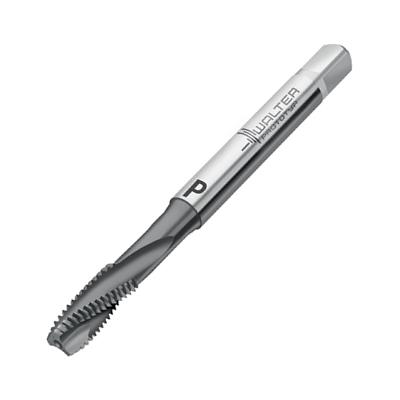
Walter has introduced the Walter Prototyp Paradur Short Chip HT blind hole tap, designed to increase process reliability and quality when tapping long-chipping high tensile (HT) strength steels.
Tapping, particularly blind hole tapping, is often a problem with long-chipping high strength materials. That's because the coiled swarf, or "bird's nest" that result can endanger the tap and force the machinist to stop the operation in order to clear out the swarf, incurring time and production costs.
The design of the Paradur Short Chip HT prevents this. It has a 15-degree helix angle for easy chip removal even in deep (3.5xD) and protected threads. This reduces to a 9-degree helix angle which, combined with a ground rake in the chamfer, ensures the creation of short chips. Axial internal cooling rinses these chips out of the hole through the spiral flutes.
In addition, the cutting edges have an adjusted rake angle. Tool life is enhanced by a proven THL hard coating, except on the reduced helix in the lower section of the tool which is ground after the coating is applied. The bare surface of the rake at this point aids chip breaking.
This combination of features enables the Prototyp Paradur Short Chip HT to reduce machine downtime, reduce tooling costs due to longer tool life, and produce clean and chip free threads. In addition, interference contour is no problem due to the short chips.
While the Paradur Short Chip HT delivers these benefits on high-tensile long chipping materials, it can also be used on low tensile strength materials such as aluminum alloys or ductile cast iron.
Contact Details
Related Glossary Terms
- alloys
alloys
Substances having metallic properties and being composed of two or more chemical elements of which at least one is a metal.
- aluminum alloys
aluminum alloys
Aluminum containing specified quantities of alloying elements added to obtain the necessary mechanical and physical properties. Aluminum alloys are divided into two categories: wrought compositions and casting compositions. Some compositions may contain up to 10 alloying elements, but only one or two are the main alloying elements, such as copper, manganese, silicon, magnesium, zinc or tin.
- flutes
flutes
Grooves and spaces in the body of a tool that permit chip removal from, and cutting-fluid application to, the point of cut.
- helix angle
helix angle
Angle that the tool’s leading edge makes with the plane of its centerline.
- rake
rake
Angle of inclination between the face of the cutting tool and the workpiece. If the face of the tool lies in a plane through the axis of the workpiece, the tool is said to have a neutral, or zero, rake. If the inclination of the tool face makes the cutting edge more acute than when the rake angle is zero, the rake is positive. If the inclination of the tool face makes the cutting edge less acute or more blunt than when the rake angle is zero, the rake is negative.
- swarf
swarf
Metal fines and grinding wheel particles generated during grinding.
- tap
tap
Cylindrical tool that cuts internal threads and has flutes to remove chips and carry tapping fluid to the point of cut. Normally used on a drill press or tapping machine but also may be operated manually. See tapping.
- tapping
tapping
Machining operation in which a tap, with teeth on its periphery, cuts internal threads in a predrilled hole having a smaller diameter than the tap diameter. Threads are formed by a combined rotary and axial-relative motion between tap and workpiece. See tap.
- tensile strength
tensile strength
In tensile testing, the ratio of maximum load to original cross-sectional area. Also called ultimate strength. Compare with yield strength.







